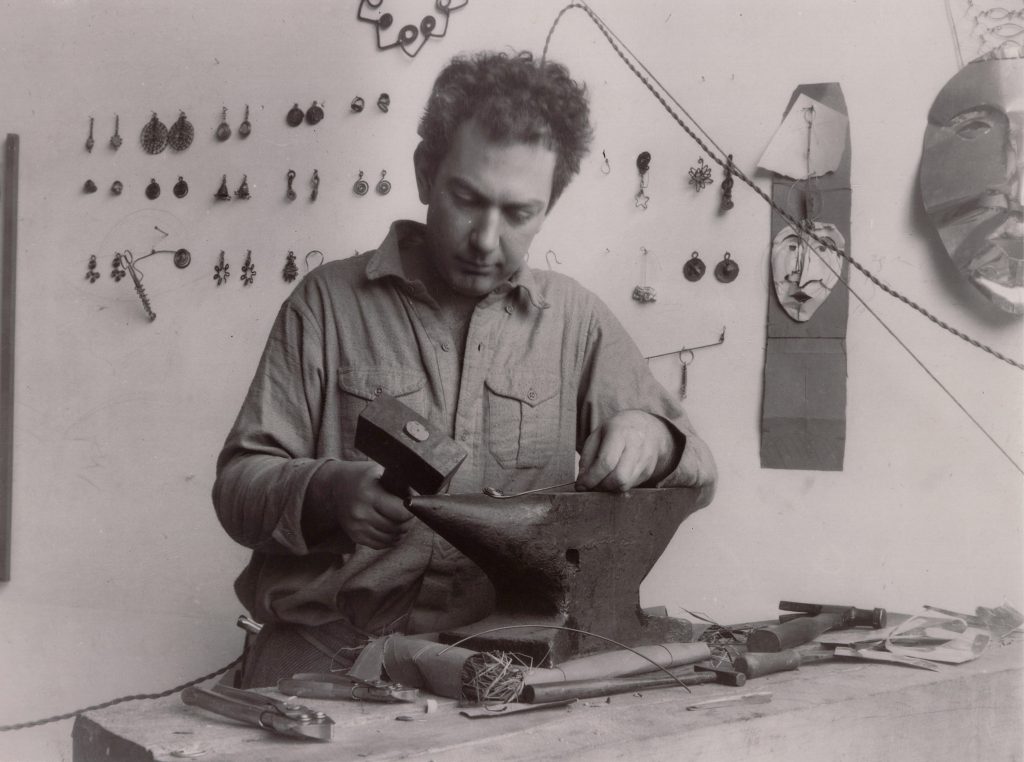
My grandfather’s bohemian, straightforward attitude was an underlying force, not only in the works of art he created, but in all aspects of his life. Living in Paris at a time when humor became a high art form, he blurred previously established boundaries that separated design, performance, and visual art. Applying his “devaluation of old aesthetic axioms,”[1] Calder approached diverse areas of object-making with the same seriousness. From his grand performance work, Cirque Calder (1926–1931), and mass-less volumetric wire sculptures to his unpretentious handmade jewelry, my grandfather did not differentiate between artistic formality and the grace of functionality.
Never satisfied with superfluous decoration, Calder used jewelry as an alternative way of communicating his artistic ideals. He developed a direct process using honest industrial materials such as brass and steel wire that he bent, twisted, hammered, and riveted in an immediate way. At once primitive and refined, the resulting works show the eccentricities of his hand expressing subtly tactile qualities.
Calder also incorporated disparate pieces of glass, pottery, and stone as his jewels. These found objects (sometimes “made” by smashing bottles behind his studio in Connecticut) were first employed in 1930 while visiting Calvi in Corsica. He collected small pieces of ancient pottery with various blue glazes and caged each one in brass wire. His veneration of these fragments of history focuses our attention on what had been passed over by others. Assembling the group with string, he sent the necklace to his mother for her 64th birthday: “I meant to write you in a birthday letter two days [ago] but I made a necklace instead—having brought along pliers and wires, and found bits of things along the parapets of the citadel, to put into it … I have been making a lot more wire jewelry—and think I’ll really do something with it, eventually.”[2] In another example of his appreciation of the usually discarded, Calder collected the chunks of an accidentally broken plate of Chinese export porcelain with a glazed fish design and fashioned the diverse shapes into silver settings. In this fine necklace, the fish motif appears in fractured images, readable only as abstract patterns.

Sure in his approach, Calder never succumbed to the many offers to edition his designs. Making jewelry was very personal for him and each piece exists as a unique work. Some of the gifts for his crowd are included here: a brass wire ring enclosing a tri-colored fragment of porcelain for Joan Miró, a gold P initial brooch for his wife, Pilar, and a silver brooch of her name for their daughter, Dolores; a reclining wire nude belt buckle for Teeny Matisse Duchamp; for Jeanne and Luis Buñuel, a gigantic flower brooch (with shards of colored glass and mirror for petals) and sliver cufflinks; for André Breton’s wife, Elisa, a pectoral disc and silver ring, both incorporating hunks of beach glass; and a fantastic brass necklace made entirely of a stylized inscription, “CALDER A BELЖA CHAGALL,” for Marc Chagall’s wife.
The superlative, early nickel silver necklace with its signature spirals is found on the wall in a fine photograph by Thérèse Bonney (1930). An ancient form, the spiral was often the singular motif in my grandfather’s work. Calder intuitively filtered forms, patterns, and symbols from organic sources and early societies into his pieces, often connecting the wearer to something primal. His charms stem fluidly from an exotic realm and, at times, seem empowered as amulets to deflect evil (or bad taste!).
Calder presented his jewelry as an invitation to join with him in eschewing the facile and pretentious. It is the intense personal connection to him and its tremendous individuality that make Calder jewelry hotly contested by collectors (even within the Calder family)! In my grandfather’s day and today, when his jewelry owners wear his pieces, it sets them apart and they make unspoken recognition as members of the Calder clan.
The Metropolitan Museum of Art, New York. Calder Jewelry. 8 December 2008–1 March 2009. Originated from the Norton Museum of Art, West Palm Beach, Florida.
Solo ExhibitionHauser & Wirth, Somerset, England. Calder: From the Stony River to the Sky. Exhibition catalogue. 2018.
Susan Braeuer Dam, For the Open Air
Jessica Holmes, More than Beautiful: Politics and Ritual in Calder’s Domestic Items
Solo Exhibition Catalogue“Calder in France.” Cahiers d’Art, no. 1 (2015). Edited by Alexander S. C. Rower.
Susan Braeuer Dam, Calder in France
Robert Melvin Rubin, An Architecture of Making: Saché and Roxbury
Agnès Varda in conversation with Joan Simon
Magazine, MonographMuseo Jumex, Mexico City. Calder: Discipline of the Dance. Exhibition catalogue. 2015.
Alexander S. C. Rower, Calder: Discipline of the Dance
Solo Exhibition CatalogueMusée Picasso, Paris. Calder-Picasso. Exhibition catalogue. 2019.
Bernard Ruiz-Picasso and Alexander S. C. Rower, Confronting the Void
Chus Martinez, No Feeling Is Final
Group Exhibition Catalogue